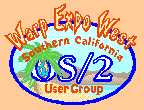SCOUG OS/2 For You - February 1999
Your Board of Directors
They Are SCOUG's Management Team
by Carla Hanzlik
SCOUG's board of directors is composed of nine members charged with carrying out the goals of the user group. In addition, the four officer positions have more explicit duties related to their particular functions.
Rollin White has served as President, Vice President, and board member. He thinks that being a board member gives you a better opportunity to make things happen. "Being involved in one of the largest OS/2 user groups gives you a chance to make a real difference with events like our Open House and Warpstock."
Gary Granat, former Vice President, echoes that sentiment, but with a dose of reality. As he points out, "It takes people with a desire to see the organization succeed and the notion that their participation can make a difference - and sufficient security in their personal and professional lives to be able to absorb the workload - to man the organizational offices and the board positions."
What Is Involved?
Clearly, as Gary noted, being a board member takes both time and inclination. Beyond that, just what is involved?
SCOUG has broadly defined objectives to support OS/2 users with educational, experimental, and other related activities. In so doing, the user group encourages both professionalism and technical competence. The board of directors makes sure this happens with the general meetings, SIGs, and every regularly scheduled and special event.
The board also makes sure that everything necessary to actually run the group gets done. SCOUG is essentially a business - a nonprofit corporation with money coming in and bills to pay. There are arrangements to be made for facilities, decisions to made about presenters, records to be kept, work to be done. The directors meet each and every month to take care of all the nitty-gritty details.
Former board member and Treasurer Michael Lavender explains that, "A board meeting in and of itself is more dependent on the individuals involved. Some issues flow on by with no discussion. Some cases have major disagreements as to how to go about a certain decision. But, all of the arguments and discussions are handled with friendliness and decorum." Michael adds that non-board members are useful at board meetings because, "they can add a fresh perspective to what, at times, is a deadlocked discussion."
The Officers on the Board
Also Have Specific Obligations
The President is the most critical position on the board of directors. The President is SCOUG's CEO with the ultimate responsibility for all the business affairs and activities of the board and the user group. This is where the buck stops.
The Vice President is sort of like a President-in- waiting, ready to step in when the President isn't there. This position comes with the possibility of all the presidential responsibilities.
The Secretary has a wide variety of record taking and record keeping duties. Just about everything related to what's written (or ought to be written) falls into the Secretary's lap.
The Treasurer maintains the user group's finances. The Treasurer handles the money, pays the bills, keeps the books, makes the reports - which means he is accountant, bookkeeper, and chief financial officer all rolled into one.
Interested in Serving?
Elections Are In March
There are three things that you should do if you'd like to be one of SCOUG's nine directors.
- Contact Bert Langer and let him know what position you are most interested in. Bert heads this year's elections committee, and he will be happy to hear from you. He'll also be happy to answer questions and give you pointers on the other two things you should do when you run.
- Put your reasons for running down on paper. Actually, send them as an email message or text file to the newsletter editor at Carla@scoug.com. Every candidate is entitled to have a statement printed in the March newsletter, and all those recieved by March 1st will be included.
- Be prepared at the March 20th meeting to give a brief talk about yourself and your goals for SCOUG. Each candidate has a few minutes of campaign air time in front of the group.
Other Ways To Become Involved
The next board of director's meeting is scheduled for Thursday, Feb 25th at 7:15 PM. It's being held at Bert Langer's home in Tustin and, as always, you are welcome to attend. Bert can give you the directions. For an agenda in advance of the meeting, contact the club's Secretary, Gary Wong.
The Elections Committee could use several volunteers to help with ballots and such. Contact Bert.
SCOUG's bylaws are on the web site at:
www.scoug.com/business/bylaws.html
Also on the web site you'll find SCOUG's ethical guidelines:
www.scoug.com/business/ethics.html
The Southern California OS/2 User Group
P.O. Box 26904
Santa Ana, CA 92799-6904, USA
Copyright 1999 the Southern California OS/2 User Group. ALL RIGHTS
RESERVED.
SCOUG, Warp Expo West, and Warpfest are trademarks of the Southern California OS/2 User Group.
OS/2, Workplace Shell, and IBM are registered trademarks of International
Business Machines Corporation.
All other trademarks remain the property of their respective owners.
| 







